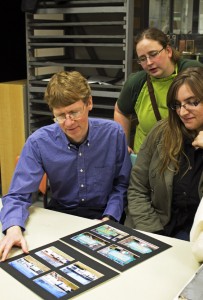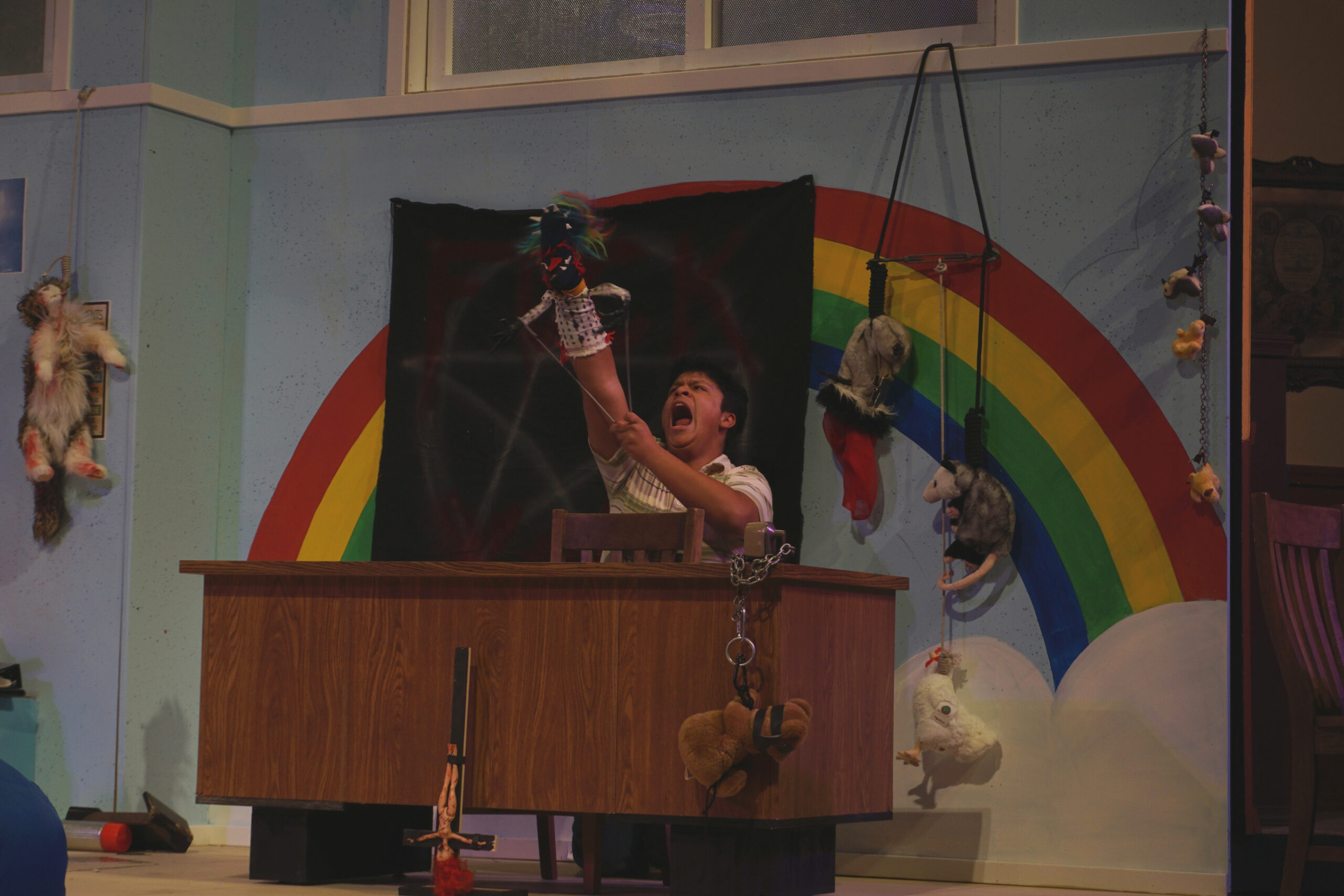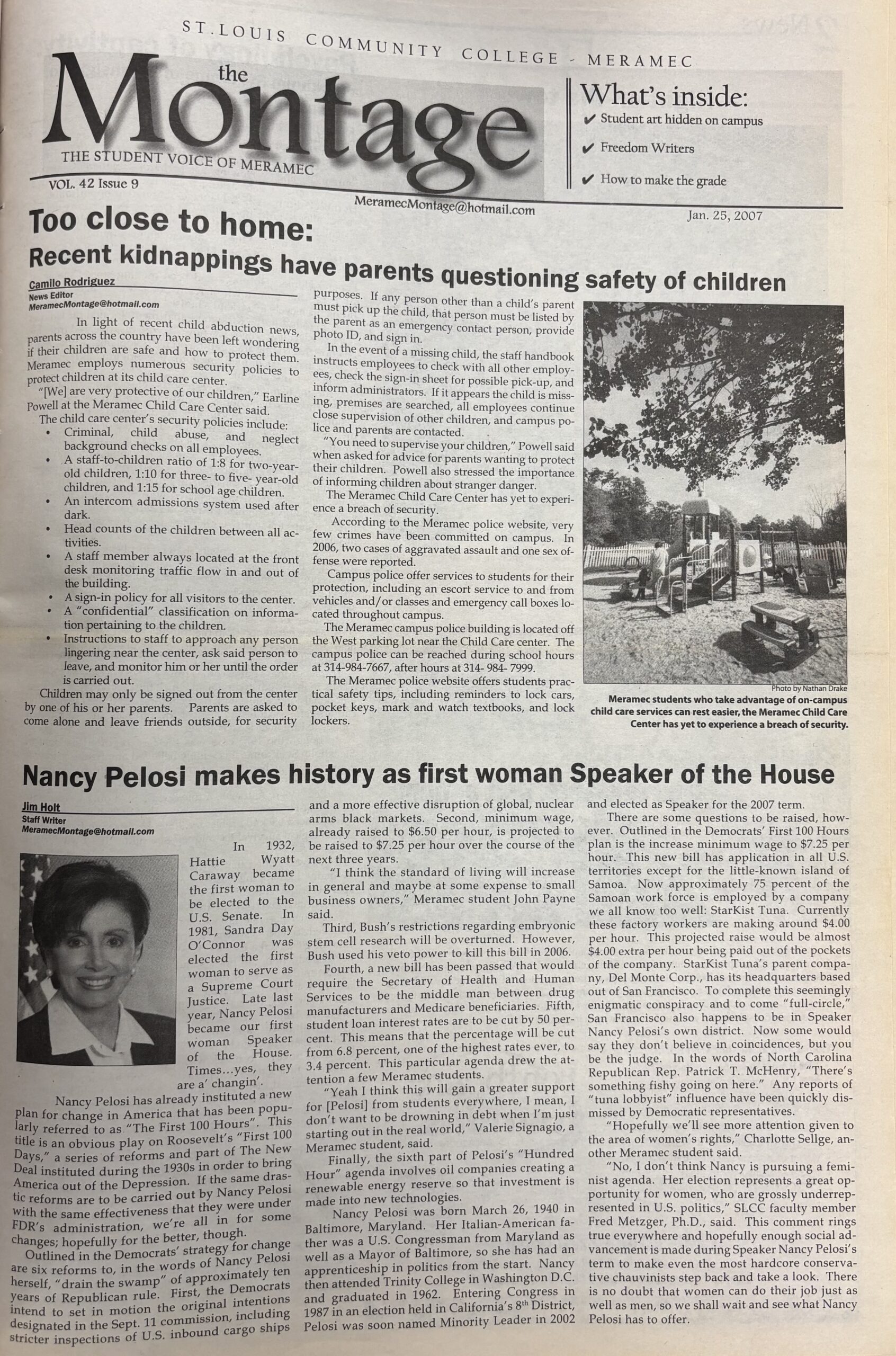Professor Hanlon didn’t always want to be a teacher, but he always knew he’d be involved in photography

Kimberly Morice
-Sr. Staff Writer-
Art books, tattered papers, overstuffed folders and a plastic dinosaur line the shelves in the corner office of STLCC-Meramec’s art department. Its owner sits, blinking behind his thinly-framed glasses, in a chair while rubbing his palms on his pant legs.
David Hanlon began his career at Meramec as a part-time professor in 1990 after receiving a history mass communications degree at Lindenwood University and a Masters in Fine Arts from the University of Kentucky. In 2002, he was hired as full time instructor and now he teaches photography and photo history.
“When I was in graduate school, since I was from St. Louis, I was communicating with artists and teachers that I knew and I would see them at conferences. When I was finishing my graduate work, two colleagues that I knew who taught at the campus were interested in finding someone to work with their students as an instructor,” Hanlon said. “From what they had known of me they thought I would be fairly successful. I was honored that they asked me to join as an adjunct faculty member.”
Hanlon says that photography is something that has interested him for many years, though teaching was not always in his plans.
“Since I was in college and I had started to work more seriously with the medium, I thought it would be an area I would personally be concentrating in. I also really enjoyed the camaraderie and the give and take of intellectual ideas that students were having in the medium, so that was an environment I wanted to stay in for an extended period,” Hanlon said.
Many changes have occurred in photography and the techniques used while Hanlon has been at Meramec.
“The department and the division has really been supportive in constantly maintaining the newest tools that are available so the students can have them right away and start experimenting with them,” Hanlon said. “The real benefit of what’s happened in the last 15 or 20 years is that there is a lot more options for artists to make work with different kinds of apparatus, so you have a lot of choices to create an impression that’s a distinct one.”
While changes to the department have occurred, one thing has stayed consistent. Like many professors, Hanlon says his biggest reward is seeing his students succeed at the end of each semester.
“A lot of folks obviously wouldn’t continue professionally with doing work a lot, but everybody takes photographs when they think they see something that they really want save,” Hanlon said. “It’s important to realize, at least for me, that I can help them gain a confidence to do that.”
Hanlon’s work within the world of photography stretches beyond the classroom. He currently has a show running at the PHD Gallery in St. Louis until March 3.
“I do my own personal work regularly. I’m always working on some new folios of things; when I’m ready I’ll propose them to people,” Hanlon said. “I write about the medium a lot too; I’m finishing up a manuscript I’ve been working on for some time on the history of the medium. I’m really involved in it all of the time, with my own work and obviously the students in my classes.”
Hanlon’s involvement in photography outside of Meramec focuses on architecture and interior spaces.
“More recently I’ve been doing studies of larger interior spaces of architecture, where the design was made to overwhelm the viewer with the scale. I’ve also been working on a new project over the last couple of years recording the Cahokia Mounds sight,” Hanlon said.
Hanlon uses the skills he has acquired from working in the field to teach students how to achieve better photographs.
“I’m really interested in having students become more interested in seeing things better, in terms of having the ideas of what they want to have achieved in a photograph that they make successfully come out, rather than having guesswork or apprehension about whether it will work out,” Hanlon said.
Art classes at Meramec often collaborate on projects; students will be shown or given one of their peers’ photographs and be expected to write a story about it or have Photoshop students work use in their projects.
“It’s great to be able to see the visual mediums really provide an ability to tie in a number of different ideas together. That really becomes important as you become involved in a number of fields,” Hanlon said.
Hanlon teaches a number of different classes at Meramec, though he says he does not favor one over the other.
“I don’t necessarily have a category of imaging that I like more than another. I’m always just excited when students become really interested in a topic or a project,” Hanlon said.
Sometimes when students begin taking a photography class, they may not know what to expect.
“Initially there are a lot of complaints because it’s not what they had expected, but then they realize after they look at the results that they’re getting some impressions that are pretty strong,” Hanlon said.
Though students may not always understand how photography works before they enter a photography course, they always have the support of Hanlon throughout their time in the program.
“Ultimately the students who are with the photographic program for a while will develop a collection of prints or a folio. The other facets of the teaching element that I really like a lot is helping a student edit a folio, collect images to strengthen the collection that they’re really happy to bring forward to show people,” Hanlon said.
Hanlon says he is always available to students who are considering a career in photography.
“When students come to visit, I always maybe give a couple of insights. One is that the field is wide open for them, if they’re worried that they don’t have enough training. Your own experiences, your own insights and feelings are really what’s primary. The skills that you gain are things you acquire over time, no one expects it to be immediate,” Hanlon said.











